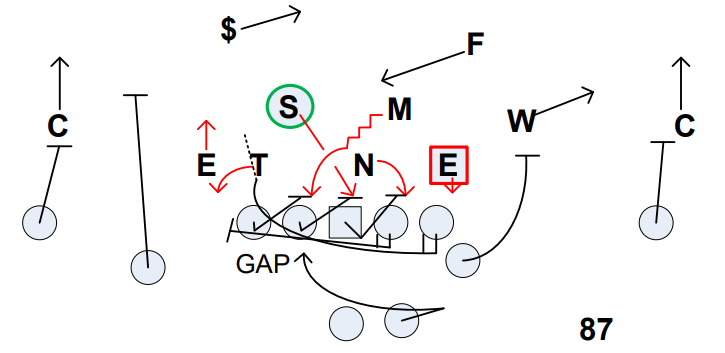
Counter is a staple of gap scheme run games. It gets linemen on the move and creates man advantage opportunities in the box. Counter can be run a lot of different ways with different players pulling and going across the formation. Who pulls sometimes changes the verbiage of what the play is called, but the core counter concept remains the same.
Read More: Snag Concept
Counter Philosophy
The counter scheme entails two offensive players pulling across the formation to the opposite side. What two players those are doesn’t really matter as far as the scheme itself is concerned.
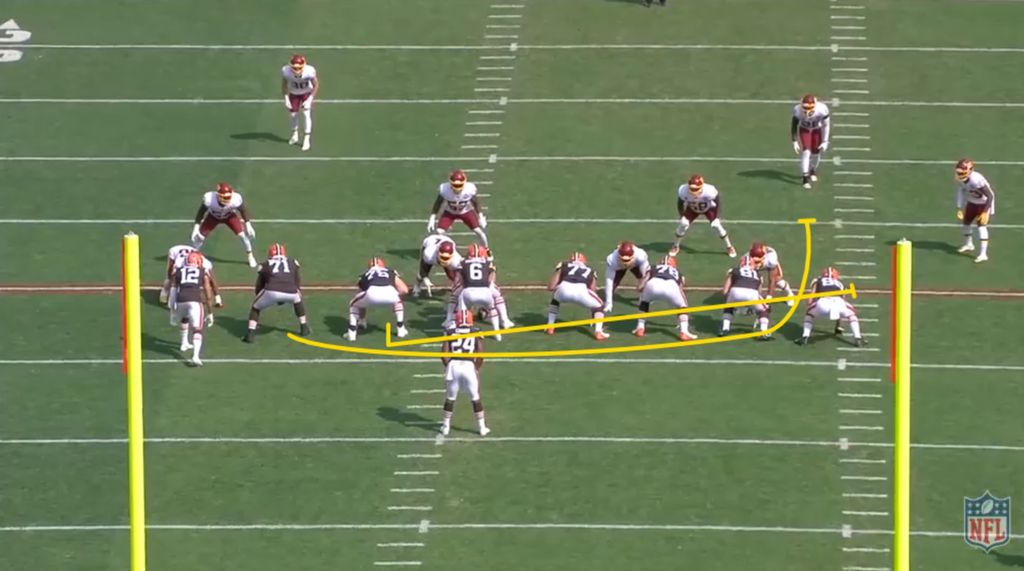
The most “true” counter is with the backside guard and tackle pulling. When teams feel like they don’t have a tackle that’s athletic and quick enough to pull and wrap through the opposite side of the formation, they’ll insert sniffers, fullbacks, or receivers to work as the wrap player instead. That can create a numbers advantage for the offense and exploit teams that over stack to the formational strength.
The first player to pull is responsible for the kick out block. Ideally, he will get the downfield shoulder of the end man on the line of scrimmage to create a lane for the second puller to wrap through.
Meanwhile, the play-side offensive linemen are working down-blocks and double teams while working to the backside linebackers. The play-side linebacker is left for the wrap player. The goal is to create a wall to prevent any backside pursuit and seal the gap outside with the two pullers.
Read More: Mesh Concept
Counter Assignments
Running Back:
- The initial track of the running back should be at the play-side A-gap
- Their track will adjust to aim for the hip of the wrap player
- Running backs must stay tight to pullers
- There is no cutback
The backfield action and initial steps for the running back can differ widely. It all depends on the formation and the look the offense wants to achieve. Timing is most important for counter. The running back cannot beat the pullers to the play-side. As a result, you often see running backs use counter steps away from the play to time things up and allow the linemen to get to their landmarks.
Offensive Line:
- Play-side Tackle (PST)
- If backside gap is filled, down-block with potential double from play-side guard towards backside linebacker
- If backside gap is unfilled, secure B-gap and work to backside linebacker
- The backside linebacker is one linebacker backside of the play-side linebacker
- Play-side Guard (PSG)
- If backside gap is filled, down-block A-gap defender
- If backside gap is unfilled, help PST on double to backside linebacker
- Must stop penetration on down-block so puller can get around
- Center (C)
- Responsible for identifying play-side linebacker
- Work to secure backside A-gap via down-block if filled
- If facing a backside 3-technique, the center must take an appropriate angle to secure A-gap defender and prevent penetration
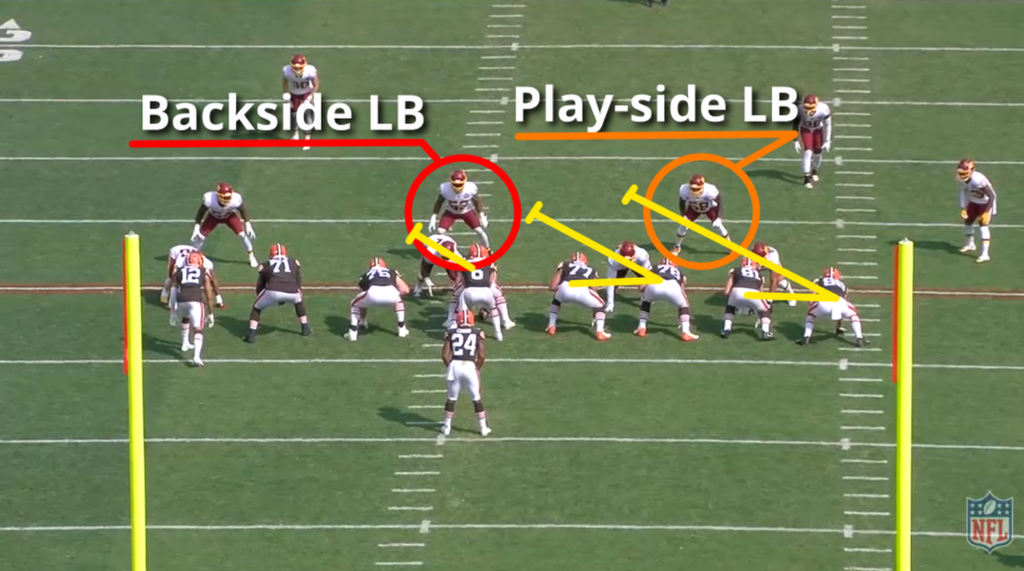
- Backside Guard (BSG)
- Pull flat working into the end man on line of scrimmage’s (EMOLS) downfield shoulder for kickout
- Aiming for first defender outside of PST
- Pull flat working into the end man on line of scrimmage’s (EMOLS) downfield shoulder for kickout
- Backside Tackle (PST)
- Pull behind PSG and work off of their block
- Wrap through and ID play-side linebacker for pickup
- Pull behind PSG and work off of their block
Tight end:
- Tight ends are an extension of either side of the line
- If backside, they help to seal pursuit from the end
- If play-side, they help climb to the backside linebacker
With slants, shifts, and different fronts, the gap for counter can shift from play-to-play. It can hit tight to the A-gap or hit outside towards the C-gap based on the look the offense gets.
Examples
The Browns are running a Guard/Tackle counter here. You can see the PST and PSG working a double team to the backside linebacker. The center is working a down-block to prevent penetration from the defensive tackle in his backside gap.
Read More: Stick Concept
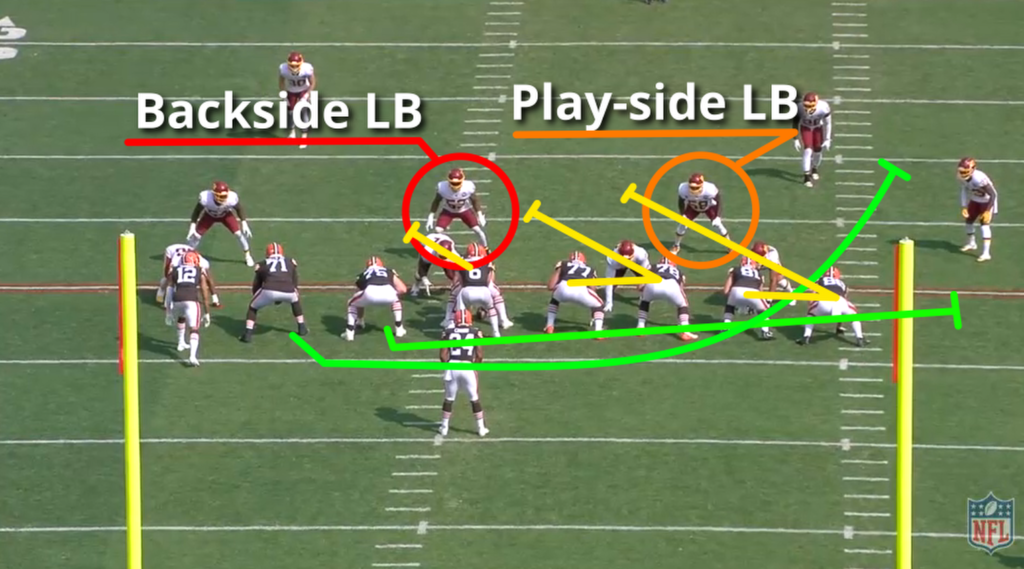
With the EMOLS is inside the two tight ends to the play-side, that means the tight ends will double him to the backside linebacker and the PSG is going to have to find the first enemy color to kick out. In this case, that’s the play-side linebacker. As #58, the play-side linebacker comes to seal, the BSG kicks him out. That leaves the BST to wrap up and through the hole while staying tight to the feet of the offensive linemen.
The Browns do a great job of creating a wall against any backside pursuit and they now outnumber Washington to the play-side.

Another variation of the counter scheme is a Center/Tackle combination. Whichever puller is closer to the play-side is responsible for kicking out the EMOLS. In this case, that’s the center. The PST and PSG work a double team down to the backside linebacker. However, with the Ravens, Lamar Jackson is also reading that backside linebacker. If he flows away from the counter, Lamar will take it himself while the running back runs an outside zone track the other way. That removes that linebacker from the play and Baltimore now has their tackle wrapping through the hole with almost nobody to block.
Read More: Smash Concept
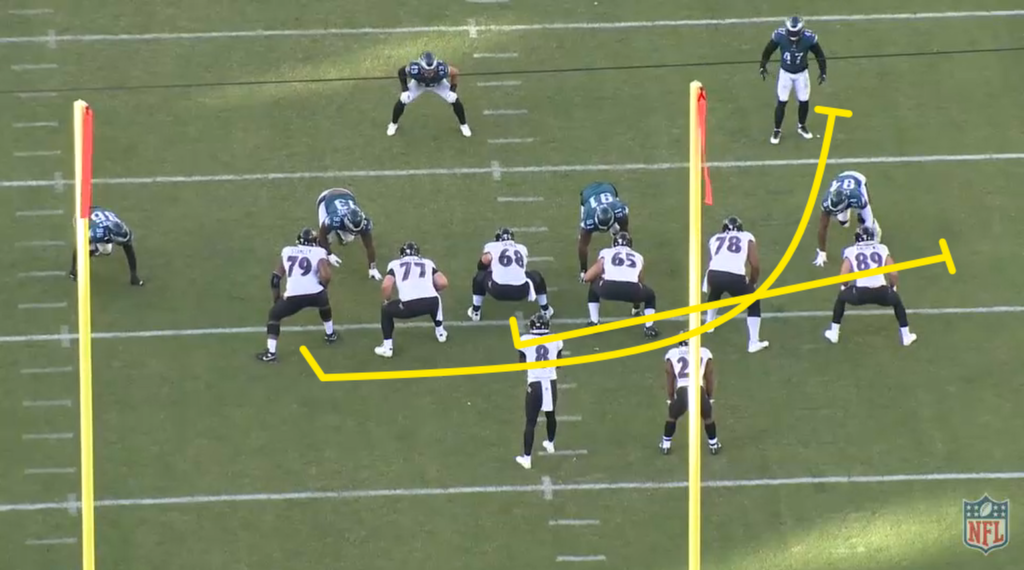
There are a bunch of ways to run counter with different pullers. The Browns are using a Guard/H counter here and leaving their tackles on the ends. What that does, though, is prevents their play-side double team from getting to the backside linebacker. The guard still kicks out the first defender that appears in the hole to fill and the H wraps through looking inside for the first enemy color since there is no double team working to that backside player.
Summary
Counter is a great way to gain a numbers advantage in the run game. If you have athletic linemen that can both pull and down-block to prevent penetration, you can exploit fast flow defenses and teams that over shift to formations. Counter creates clear lanes, has misdirection, and helps get the running back onto the second level.
